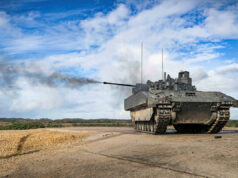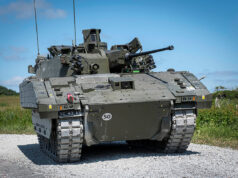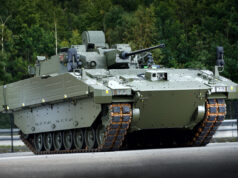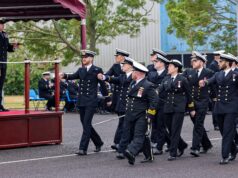The gun systems, produced by BAE Systems, were accepted earlier this year, as part of a 145-gun agreement between the US. and Indian governments.
The 155mm M777 systems will deploy to their first regiment in 2019.
“The Indian Army is receiving an extremely reliable and battle-proven artillery platform,” Joe Senftle, vice president and general manager of BAE Systems’ weapon systems business, said while attending the event.
“The M777 brings a new level of capability to the artillery unit by offering rapid deployment and extreme accuracy. It can operate in areas that are difficult to access and is also very easy to maintain.”

BAE Systems is building and delivering the first 25 M777 ULHs fully assembled, with the remaining 120 to be assembled in India by Mahindra Defence Systems Ltd. (MDSL) under an arrangement designed to support defence industrial cooperation and promote local economic growth.
“The M777 ULH is more than a very effective piece of artillery technology,” said Nik Khanna, managing director India, BAE Systems.
“With the M777 program, BAE Systems has made the first step of our substantive Make-in-India commitment, which includes our pledge to develop a network of Indian suppliers for our global supply chain and deepen our relationship with industry in India. We are committed to a strong and collaborative working relationship between BAE Systems, the Indian Armed Forces and Indian industry.”













Okay guys which one of you wants to be the first to demand we buy some ?
Is it better than the Light Gun?
Very. Larger and more powerful shells and much longer range. Especially when used with guided munitions.
Thank you Elliot.
I guessed as much.
In which case why is it not being procured for the Royal Artillery who’s main gun regiment strength now lies in 4 regular regiments of 1970s Light Guns?
There will shortly be only 2 regiments of Self Propelled 155mm guns left.
The other 4 were removed in “modernisation” reviews FAS Future Army Structures, Army 2020, and now Army 2020 Refine.
The RA trialled it during it’s development. Never heard why it wasn’t procured. The 105 is passed its usefulness. Have had the pleasure of calling it in during Herrick we weren’t particularly impressed with its effectiveness to saturate an area despite having 5 of them on neutralise
While the light gun is old, it is still effective, and accurate out to 17.5 KM. It has an APS (automatic positing system) which constantly updates while on the move etc and can be brought into action from the traveling position in under 2 minutes. Yes its 105 mm shell doesn’t have the bang as a 155mm but it was the weapon of choice (after the GLMRS) on many targets, as the fear of collateral damage was high on the agenda of the brass on Herrick. It can be moved under slung very easily, and internal in a Chinook.
It has a number of proximity fuses, high, normal, low, Point detonate, (although the illum is crap and we preferred to call in 81mm illum) and can be used surprisingly accurate from a static position for direct fire. And no, hang on, I am not trying to sell any, but its the gun the Army has the most of, and the one we are currently stuck with. Is it suitable for the new (bad idea IMHO) strike Brigades? no, is it good for armoured formations? no, but it as ideal weapon for the Airborne/Commando roll, (and the old AMF).
One of the reason the 155mm wasn’t adopted was that no matter how “light” a gun is in the 155mm calibre, the ammunition and logistics are still heavy, and the logistic chain was considered to much of an issue. It is what it is, the L118 has another 20 years left in it, but yes it is old, there are power supply issues and spares are getting harder to get. But we still have over 100 still in store so it will be around for a while yet.
Perhaps Boxer and Ajax become platforms for 155mm to enable shoot and scoot capabilities that are just not practical timewise for M777, still complementary to the L118 though, not a replacement. Both Boxer and Ajax provide modern platforms and both (i.e. Ascod) have been prototyped with 155mm. The US is also exploring low recoil 155mm that could use a standard truck chassis –
http://www.thedrive.com/the-war-zone/24663/army-tests-low-recoil-155mm-howitzer-small-enough-to-fit-on-the-back-of-a-truck
The bottom line is that the logistics to support 155mm seem to dictate a mobile platform with mobile support, which may be why the UK never went down the path of M777. The US of course has a significantly greater logistics capability so for them M777 has made sense, at least up to this point.
Do we need them?
Actually, an area I am always curious in is what arrangements do we have should the crap hit the fan tomorrow, and a multi frontier war open up. Do we have huge amounts of artillery, ammunition’s etc stock piled to rapidly enlarge our forces, or do we have the ability to take over industrial sites to manufacture new kit overnight and churn out in large quantities? Or do we have to wait 6 months for foreign arms manufacturers to agree on a contract and then delivery another 6 months down the line? I would hope we have significant emergency plans in place.
Well our Defence Munitions sites like Kineton and Glen Douglas are huge.
How much is actually in them I’ve no idea.
My guess is that it’s all been reduced like everything else.
Generally I think the Royal Artillery should be expanded, cheaper than fast air.
Cheaper than fast air but nowhere near as versatile. Fast air has much greater range and accuracy and can perform a wider variety of tasks.
Same with Apaches, for instance. I’d like to see more of them acquired. All army helicopters really; that’s where the army is really lacking.
Without doubt.
So a balance needed.
Money tight.
Money is indeed tight but even if Gavin Williamson was able to pull off a miracle and get 3% for Defence then we’d still have to be careful about what we spend.
Aircraft for the army.
More frigates and destroyers for the Navy.
More Typhoons and F35s for the RAF (and navy for the latter)
I hear the US DoD is buying $180 million worth of M4 for about $600 each. I think that is about what £470 per rifle.
Air isn’t the answer to everything.
Half the Army’s operational budget already goes towards to helicopters.
The RN needs more Merlin but that is because we are running out of aiframes not because we need more in the field.
Steve
Air is no substitute for Artillery. The only thing that made Air more potent in theory was guided munitions. Artillery now has guided shells available. Those shells have vastly increase their range and first hit probability.
Considering Artillery is only limited by the Rules of Engagement and the supply of ordnance available. In which case a battery of guns can keep shelling until they run dry. While Air is restricted by pilot/aircraft availability, runways, refueling assets, and payload restrictions.
I wasn’t talking of air replacing artillery sorry. Simply that air has bigger impact on the outcome of a war so more should be invested in it.
In a war against a peer enemy, we’ll need all the aircraft and ships we can get.
It is the combined logistical ease of getting something into a firing position that is key. This is why air power is so good because you only put the plane into a forward position. For artillery you need to drive and protect it 500 miles from port to front line with ammo, fuel, people, water, food, etc. It can take tons of supplies and weeks of work to deliver a kg of HE and even then the big artillery is not very mobile.
Air power could be a 155 shell with a wing pack and GPS kit to make a nice little air dropped glide bomb and a Gulf Stream jet modified for bombing for example could carry 200 of those without mobility or logistics problems and still fly 4000 miles.
For efficient land mobility you could have an 8×8 vehicle with a 76mm gun like a truck mounted howitzer. Using 12kg shells with 16km of firing range it would effectively be an all terrain heavy mortar integrated as part of the infantry, and it would have commonallity with the worlds most popular naval gun.
I hear the US DoD is buying $180 million worth of M4 for about $600 each. I think that is about what £470 per rifle.
Ah get two one each ok.
The limitation on M777 vs Light gun is the supply chain of ammunition. It’s much heavier and much bulkier. Not a big deal in a road supplies mechanised force. Definitely a big deal in an air supplied force such as 16 AIRMOBILE, or 3 Commando. Feeding the guns would soak up all the utility lift available. No wonder we’re buying more Chinooks rather than Puma’s or Merlin. FWIW I think M777 will come for the Strike Brigades. Eventually. What the air supplied forces will do is a worry. Probably pull in more Chinooks and suck it up.
That would be the reason the M119 (the Light Guns US designation) is continuing to be upgraded for the US Airborne and light infantry units.
In the Falklands moving guns and resupplying them really showed up how many helicopters we needed for that type of warfare. There were no Junglies left to move the Commandos forward.
A 120mm mortar might be an option to replace the light gun especially if there is naval 5in with PGM supporting. But if M777 can take fire PGM too we might need fewer rounds.